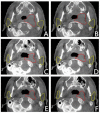Clinical study of the time of repeated computed tomography and replanning for patients with nasopharyngeal carcinoma
- PMID: 28404877
- PMCID: PMC5432355
- DOI: 10.18632/oncotarget.16770
Clinical study of the time of repeated computed tomography and replanning for patients with nasopharyngeal carcinoma
Abstract
Purpose: To study the necessity of repeat computed tomography (CT) scan and replanning and know a more accurate time using weekly kilovoltage cone beam computed tomography (kV-CBCT) scans for patients with nasopharyngeal carcinoma (NPC) during radiotherapy.
Methods and materials: Thirteen NPC patients treated with IMRT were enrolled into this prospective study. Weekly pretreatment kV-CBCT scans were performed on the 1st, 6th, 11st, 16th, 21st and 26th radiation time, respectively. Target delineations were contoured on all fractionated CBCT images, including the gross tumor volume of the primary nasopharyngeal tumor (GTVnx) and parotid glands. The volumes of GTVnx and parotid glands were calculated automatically using the Pinnacle3 8.0 system. Compared to the original GTVnx, the percentage of shrinking volume (ΔP) ≥ 50% was considered significantly.
Results: As the radiation proceeding, the GTVnx had a trend of shrinkage. Of all 13 patients, 11 cases (84.6%) had the volume shrinking ≥ 50% before the 21st radiation and 12 cases (92.3%) before the 26th radiation. And the parotid volume decreased significantly in the first four-week radiation, 6.45 ± 3.16cm3 (range, 3.06-13.9cm3) for the left parotid gland and 5.78 ± 2.39cm3 (range, 2.70-11.2cm3) for the right. Furthermore, only a little displacement occurred to bilateral parotid glands.
Conclusion: The replanning for NPC patients with IMRT is necessary, and the time between the 21st to 25th radiations is appropriate.
Keywords: cone beam computed tomography (CBCT); displacement; gross tumor volume (GTV); nasopharyngeal carcinoma (NPC); parotid gland.
Conflict of interest statement
The authors have no conflict of interest.
Figures






References
-
- Al-Sarraf M, LeBlanc M, Giri PG, Fu KK, Cooper J, Vuong T, Forastiere AA, Adams G, Sakr WA, Schuller DE, Ensley JF. Chemoradiotherapy versus radiotherapy in patients with advanced nasopharyngeal. Cancer: Phase III randomized Intergroup study 0099. J Clin Oncol. 1998;16:1310–1317. - PubMed
-
- Hunt MA, Zelefsky MJ, Wolden S, Chui CS, LoSasso T, Rosenzweig K, Chong L, Spirou SV, Fromme L, Lumley M, Amols HA, Ling CC, Leibel SA. Treatment planning and delivery of intensity-modulated radiation therapy for primary nasopharynx cancer. Int J Radiat Oncol Biol Phys. 2001;49:623–632. - PubMed
-
- Kam M, Chau RM, Suen J, Choi PH, Teo PM. Intensity-modulated radiotherapy in nasopharyngeal carcinoma: Dosimetric advantage over conventional plans and feasibility of dose escalation. Int J Radiat Oncol Biol Phys. 2003;56:145–157. - PubMed
-
- Lee N, Xia P, Quivey JM, Sultanem K, Poon I, Akazawa C, Akazawa P, Weinberg V, Fu KK. Intensity-modulated radiotherapy in the treatment of nasopharyngeal carcinoma: an update of the USCF experience. Int J Radiat Oncol Biol Phys. 2002;53:12–22. - PubMed
-
- Lin S, Pan J, Han L, Zhang X, Liao X, Lu JJ. Nasopharyngeal carcinoma treated with reduced-volume intensity-modulated therapy: report on the 3-years outcome of a prospective series. Int J Radiat Oncol Biol Phys. 2009;75:1071–1078. - PubMed
MeSH terms
LinkOut - more resources
Full Text Sources
Other Literature Sources
Medical
Research Materials

